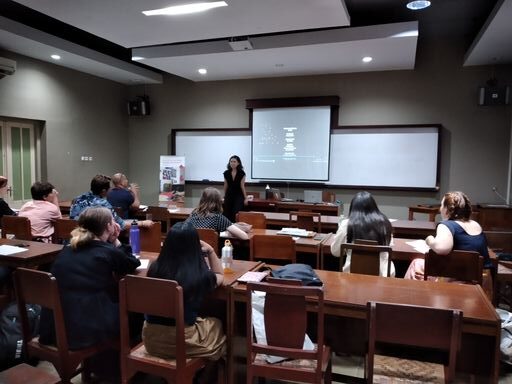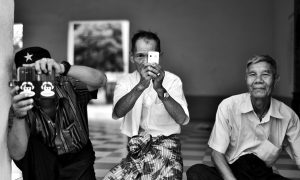Recent months have seen dreadful attacks on the value of knowledge about, and from Asia in Australia—indeed in recent days on the pursuit of knowledge in general. While our politicians defend themselves from accusations of endemic and systemic racism on the one hand, on the other successive governments on both sides have trotted out a long running series of education policy changes around Asia literacy in particular, aid funding diversions and budget cuts that erode the foundations of their professed aspirations to lead in the region.
The National Library of Australia, after a series of, again, long-running budget cuts to cultural institutions, has closed its Asian Collections Room. It has cancelled subscriptions to hundreds of Asian periodicals, and shifted all bar three Asian nations out of its priority list. Those collections, for scholars of Asia, are invaluable. Many of the publications are not available to the public, even in the countries from which they originate.
It’s not an esoteric, academic ivory tower in there. As Tessa Morris-Suzuki pointed out in the Sydney Morning Herald, these texts are fundamental, directly or indirectly, to the education of our current and future journalists, diplomats, politicians, business people, security strategists, economists, humanitarian workers, activists, artists and litterateurs—as well as our historians, anthropologists, tour guides and most importantly, our teachers. They are fundamental to understanding who we are, where we are, where we come from (literally, for many) and what futures might be available to us.
As Ed Aspinall detailed for Inside Story, after many decades of leading Australia’s intellectual engagement with Asia, the NLA has suffered a pincer move comprised of the necessary but expensive shift to digitisation accompanied by reduced funding, staff and expertise. The result is that “collections that have been developed over decades will now wither on the vine of neglect.”
Once upon a time, Australia turned itself outwards to Asia. It’s the story of my family and many others. My grandfather first ventured out of a tiny farming town to sign up for service in the Pacific War. The reality of war and especially his experiences in the repatriation of POWs from Ambon devastated him, but there are too family photos of him leaping joyfully from a jetty into the Banda Sea. In the mid-1970s, at age 16, my mother set off to the Philippines for a year on Rotary exchange. A decade or so later, with 3 children 5 years and under, she and my father returned for my father’s work on an aid project in Zamboanga del Sur. In the late 1980s we spent two years in remote West-Timor.

My sociology class, studying in Indonesia in 2001 at Universitas Gadjah Mada “on ACICIS”. Photo courtesy the author.
For me, these experiences and family history have been formative, but so too were the educational policy and social environment that facilitated our encounters. Many Australians share similar experiences, and many of them have continued that connection in their lives, their careers, their passions. With difficulty, and often at great cost, we’re trying raise our children to understand where they are in the world, Australia’s place in the Asia-Pacific. But it’s getting harder all the time. Anecdotally, fewer Australian schools offer Asian languages, but comprehensive national data has not been collected since 2011. As a country, we’ve come to know less about our nearest neighbours. A Lowy Institute survey revealed that less than half of Australians know that Indonesia is a democracy.
The global pandemic has deepened the impact of long-running reductions in funding for Asia literacy in schools and higher education. It threatens to make casualties of in-country language learning programs, student-exchange opportunities and youth mobility. Some of these will return if and when international travel is viable again, but for programs like the Australian Consortium for In-Country Indonesian Studies (ACICIS), it’s 25th year of introducing Australian university students (over 3,500 so far) to Indonesia may well be its last.
I “went on ACICIS” as a second-year uni student. As it has for so many others, it changed the course of my life, my career and my world-view. For the past four years I’ve also had the privilege of teaching a summer intensive with ACICIS, witnessing students’ horizons expand through an expertly guided learning experience. But ACICIS is funded by student participation, often with the support of New Colombo Plan scholarships. No rescue package has been forthcoming for this small part of the greater higher education sector, and the consortium has resorted to a public fund-raising appeal in the hope it can make it through the uncertainty.

Australian students in Indonesia on an ACICIS program. Photo courtesy of the author.
In-bound student mobility—international students from Asian countries and the rest of the globe—has certainly take a huge blow and carries enormous ongoing financial consequences. Perhaps more importantly, it will also impact the nature of studying at university and living in a university community. It will be a much less linguistically, culturally and ethnically diverse university classroom that students walk back into around the country next semester.
And who will be teaching? Likely fewer of those academics living with the precarity introduced by growing casualisation, who are also now likely to be jettisoned from a sector that has been shut out of government support during the COVID-19 crisis, and now threatened with systematic defunding—fewer women, fewer people of colour, fewer people from Asia.
From late 1980s to the mid-90s, when I was busily exerting my linguistic muscle in high school competitions, Indonesian language university courses were experiencing a surge in popularity stimulated by the influence of the National Policy on Languages, which emphasised Asia’s importance to Australia’s future. By the time I joined the Indonesian studies cohort of the late 90s, a two-decade decline was beginning, according to ACICIS’ founding director, Professor David Hill.
Indonesian studies is not the only field of Asian studies under attack. Hill’s article was penned for a series of short articles reviewing the state of Asian studies in Australian universities, written and researched by leading academics in their fields and published by the Asian Studies Association of Australia’s (ASAA) blog, Asian Currents (of which I am also the editor). It was disturbing reading.
South Asian studies has contracted from nearly 80% of universities offering courses on India in 1989, to just over 17% in 2019. Enrolments in Japanese studies have risen over the past 20 years but these are largely international students, so the field will be disproportionately impacted by the current crisis and remains at risk from the large numbers of casualised positions. Study of Chinese languages has expanded but also suffers from a lack of domestic enrolments, leading Professor Anne Mclaren to note that “Australia still has too few Australian China specialists to meet the national need for expert engagement with our largest trading partner.” Korean studies are flourishing, but due more to the proactive actions of the South Korean government than investments from our own government. Associate Professor Ruth Barraclough of ANU bemoans that, in spite of growing enrolments, “constantly having to make the argument to fund new continuing positions is dispiriting and exhausting.”
The one field of study to record growth and consolidation, according to the ASAA reviews, is mainland Southeast Asia. The positive outlook is encouraging, but nonetheless, the author of that review writes that studies of mainland Southeast Asia are marginalised by the same challenges facing other humanities faculties in Australia, which are “stubbornly Anglocentric in content and outlook, despite our geography, economy, security considerations and changing demography.”
Penny Wong weighed into this space recently, saying that, “In a time where Australia should be looking to improve and expand our engagement in Asia, the NLA’s decision is alarming, and is counter to our national interest.” In terms familiar to university staff across Australia, the NLA spokesperson conjured up the twin jinn of the “funding envelope” and “efficiency dividends”, stating that the collection has been “much less used” than the funding expended warrants. It’s hardly surprising. Our knowledge of Asia, our learning, our relationships and our expertise have been under fire for the last 20 years. If fewer primary school kids learn Asian languages, fewer high schools teach Asian history and fewer students enrol in Asian studies degrees or take up research or teaching in the field, who is there to do the reading?
 Facebook
Facebook  Twitter
Twitter  Soundcloud
Soundcloud  Youtube
Youtube  Rss
Rss 

